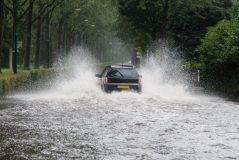How to Safely Drive through Floods
Floods can occur anywhere and happen quickly or rise slowly – in areas with lots of rainfall and low roads. Flash floods are the number one weather-related killer in the United States — most flood fatalities happen because people attempt to drive through flooded areas.
The first rule of driving in flooded areas is don’t do it — find another route. That’s the only sure way to avoid getting stranded. However, if you can’t avoid it, then a good rule of thumb is don’t drive anywhere you wouldn’t walk through. It only takes six inches of standing water to touch the bottom of most sedans, which can cause loss of control or stalling of the engine as water is sucked into the exhaust or into the air intake. Although your car insurance may cover your damages, you may be forced to buy a new car if yours is declared a total loss.
If the water is moving, remember, one foot of water can sweep away most cars. Two feet of rushing water can sweep away SUVs and pick-ups. It will also hard to see dips in the road, so proceed with caution, and pay attention to what’s going on around you – watch how other cars navigate on the road to determine the depth of the water, identify areas that dip down, and try to figure out the best possible route to safely drive through.
Other tips:
• Avoid driving in water that downed electrical or power lines have fallen in — electric current travels through water.
• If you decide to drive through the water, stay in the middle part of the road since it tends to be the highest point.
• Drive slowly, don’t “speed through” (the force could possibly create waves that can push water into the engine).
• As you drive slowly through standing water, use a low gear so the engine rev’s are higher; water in the exhaust could otherwise damage the catalytic convertor
• Look out for people driving towards you from the opposite direction; if larger cars come through quickly it could cause waves which can make it dangerous and more difficult for your car to get through.
• Go through an area one car at a time in one direction.
• If your car stalls as you’re driving through the flooded area, don’t try to open the hood.
• If your car stalls and if you can safely make it to higher ground on foot, leave the vehicle and do so.
Taller cars with four-wheel drive may fare better than normal passenger cars, however, they still need to drive carefully and slowly. Even in areas where the water is shallow, if you go too fast, it can lead to hydroplaning (leading to loss of steering and control of the car). If you do experience hydroplaning, hold the steering wheel lightly and lift off the gas pedal until the tires regain grip. This is one of the common issues when driving through even a small amount of water, so don’t speed.
If you have comprehensive coverage on your car insurance policy and your car’s totaled by flood damage, your insurer will work with you on a settlement. But, the best thing you can do is just avoid driving through flooded areas in the first place.
Have you ever been caught in a flood? Feel free to share your thoughts and experiences in the comments section below.



